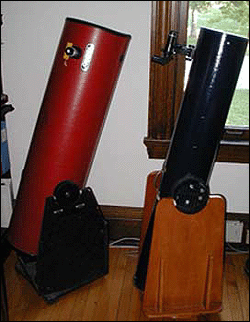
Two Dobsonian telescopes. The tube of a Dobsonian telescope is easily removed from its base, making for easy transport. Credit: NASA
Many people who want to view their star through their own telescope go out and buy a telescope right away, but later find that the expensive telescope they bought doesn’t really suit them. Or they eventually determine that they really didn’t like astronomy as a hobby like they thought they would. Either way, their telescopes end up buried in a closet, basement or attic, and they find that they’ve wasted a lot of their hard-earned money. Many needlessly burn out on a hobby they might otherwise have enjoyed the rest of their lives if they had only taken a more measured approach in the beginning.
It’s really best to ease into astronomy, learn about the different types of telescopes, try using a few, become an educated consumer, and then make a purchase. A great way to start is to get the following:
- a low-cost pair of binoculars;
- a really good book entitled Nightwatch: A Practical Guide to Viewing the Universe, by Terence Dickinson;
- a subscription to Astronomy magazine; and
- Name A Star Live’s First Light Astronomy Kit, included in the Ultimate Stargazer’s Gift Set, which brings together essential resources a beginner needs to get started observing the stars, including:
- The Night Sky, our uniquely designed low-distortion planisphere;
- Exploring the Night Sky with Binoculars, our award winning introduction to observational astronomy; and
- Sky Atlas for Small Telescopes and Binoculars, our sky atlas designed specifically for beginners with small optics.
These tools will help you learn the constellations (areas of the night sky), and otherwise help you get started stargazing. Also, consider joining a local astronomy club where you can gain experience using various types of telescopes before making a purchasing decision.
But if you feel you really must buy a telescope right away, then purchase what is called a “Dobsonian” telescope. Dobsonian telescopes (or “Dobs”) are relatively low-cost, yet high-quality telescopes. Generally speaking, they do not have any high-tech, computerized gadgets on them. Yet their optics are just as good as the overwhelming majority of computerized (“Go To”) telescopes that cost thousands of dollars. Once you gain some experience using a Dob — and should you decide to make astronomy into a serious hobby — you might eventually purchase a more expensive telescope, such as a “Schmidt-Cassegrain” or “apochromatic refracting telescope.” But start with a Dob!
Astronomers compare telescopes primarily by the diameter of their main (“primary”) mirrors. This is referred to as the “aperture” of the telescope. You’ll want to get a Dob with an aperture of either:
- 6 inches (150 mm)
- 8 inches (203 mm)
- 10 inches (254 mm)
If you can afford it, go with either an 8 or 10 inch version: The larger the diameter of the mirror, the easier it is for you to see dim objects (like stars) in the night sky.
In addition to the aperture of the telescope, you might also want to consider the “focal length” of the telescope: The longer the focal length, the greater the magnification. Magnification is not so important when you’re observing stars as stars appear as a single point of light no matter how much you magnify the view. But greater magnification will be a big plus when you aim your telescope at the Moon and planets.
So, when considering the aperture and focal length of a telescope, remember the following:
- If you’re comparing two telescopes that have the same aperture but different focal lengths, go with the telescope that has the longer focal length.
- Aperture is more important than focal length for observing dim objects, like stars, galaxies, and nebulae.
For Dobsonian telescopes, prices range from roughly $350 USD for 6-inch apertures to $900 USD for 10-inch apertures. The telescope should come with two or three eyepieces. If it doesn’t, shop somewhere else.
Whatever you do, don’t buy a telescope from a department store! Those telescopes are toys. Instead, either buy from a store that specializes in telescopes, or buy online. Good brand names include Orion, Celestron, and Meade.
Clear skies to you … and remember: Keep looking up!